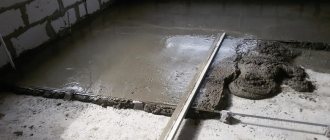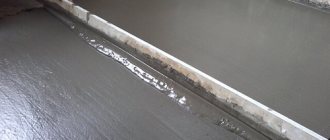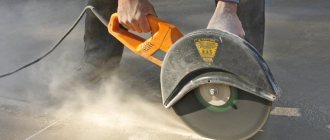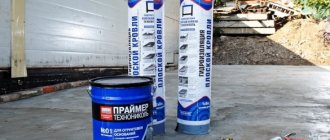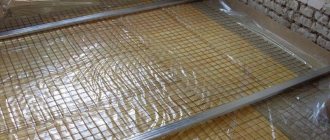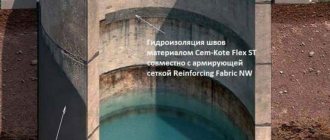The technology of pouring self-leveling floors compares favorably with concreting screeds in its high productivity and low labor intensity. There is no need to set beacons and level the mixture; it is enough to distribute it evenly in separate areas of the room. In a single horizontal level, the self-leveling compounds will spread on their own; the master will only have to expel the air bubbles with a needle roller.
How does a self-leveling floor differ from a leveler?
When searching for “self-leveling floor,” the search results in bathrooms and toilets with images of the jungle, clouds, or seabed on the floor. In practice, instead of paintings, masters pour some kind of gray liquid mixture.
A self-leveling floor is usually called a method of leveling horizontal surfaces when the plane is filled with liquid cement-based binder. Since the mixture is liquid, it always forms horizontally. A perfectly flat surface subsequently allows you to perform any type of finishing, from tiles to gluing prints with images.
Manufacturers often name these materials differently, which often gives rise to many misconceptions. For example, instead of the name “self-leveling floor,” the bag may say “self-leveling mixture,” “liquid leveler,” etc.
In the box: Knauf uses the name “self-leveling mixture”. Ceresit uses the phrase “thin-layer leveler”, Weber often uses the more familiar designation “self-leveling floor”.
Leveler the name can mean both a mixture for a self-leveling floor and a “classic” cement-sand screed.
Repair of loose screeds and cracks
When pouring the screed to prevent cracking, we recommend adding various plasticizers to the solution, which prevent the settling of heavy particles and make the screed plastic, without cracks. We recommend plasticizers from the Italian company Mapei, presented on the Ukrainian building materials market, Dynamon Easy 11 based on modified acrylates. This drug belongs to the latest developments of Mapei Dynamon System additives, produced using the “Designed Performance Polymer” technology - polymers with specified parameters. Using the additive significantly reduces the water consumption for preparing the solution, which in turn will reduce the drying time of the screed and its further repair.
How do self-leveling floors differ from screeds?
In order not to make a mistake when choosing a mixture, we will consider the main differences between the two technologies.
- Rough levelers (screeds) - in most cases they are a cement-sand mixture. They allow you to form a large layer from 3 – 5 cm to 15 cm. Leveling is done manually using a rule and steel beacons, so small errors may remain. The main advantage of screeds is the low price for the material; the disadvantages include high labor intensity and a long hardening time for the solution.
It takes 28 days for a “wet” screed to gain strength. During this period, you need to periodically moisten the surface and, if necessary, cover it with film. Otherwise, the coarse leveler will not be able to gain strength and will crack.
- Liquid levelers (self-leveling floors) are modified compositions based on a cement binder. They are always more expensive than a coarse leveler, but the pouring technology allows you to get a perfectly flat surface for any coating option. In addition, drying takes several days rather than a month. From a labor-intensive point of view, leveling with a self-leveling floor is easier.
In most cases, both technologies are used to level the floor; first, the floor is raised to the desired level using a screed, and then a smooth surface is formed for subsequent laying of the finishing coating.
Material selection
When choosing the type of finishing floor to pour onto a concrete screed, consider the following nuances:
- Inexpensive cement-acrylic mixtures are poured in rooms with high humidity, where the floor is constantly in contact with water: kitchen, bathroom. A finishing coating (tile, linoleum) is laid on top of such floors.
- In residential heated premises with a constantly dry microclimate, gypsum-based floors are poured.
- If the room has a heated floor, then the finishing coating should have elasticity and the ability to expand without cracking due to temperature changes. The best option is polyurethane or epoxy-polyurethane mixtures. This option is also chosen to create a 3D floor.
- If the subfloor was completed a long time ago, and the finishing coating needs to be done in a short time, choose quick-hardening (methyl methacrylate) mixtures.
The choice of materials is huge. If the old base is strong and level, it is permissible to immediately pour one layer of a compound designated “extra strong.” You can use universal compounds with a wide range of minimum and maximum thicknesses, and use them immediately for both roughing and finishing work.
Foundation assessment
- Before using self-leveling floor technology, you need to correctly assess the base on which the leveler is to be poured.
- If the repair is being carried out in a new building, where there is already a “rough” screed, then you need to check its quality: look at the level and tap for the presence of internal voids. Grease and bitumen stains must be washed off the surface.
- If the new building does not have a “rough” screed, but the floor level is satisfactory, then you can immediately pour the finishing leveler.
- In houses with an old foundation, it is better to remove the covering and make a new screed. After such preparation, you can begin pouring the self-leveling mixture.
If the time for carrying out work is limited, then quick-hardening mixtures should be used. Otherwise, you will have to wait a month for the screed to gain brand strength.
- Also at this stage, the possibility of installing sound insulation and insulation should be taken into account. In this case, the thickness of the floor “pie” will need to take into account the thickness of the EPS boards.
Brief information about the features of concrete screed
Over time, cracks and scratches appear on the concrete surface, which inevitably leads to the need to level the flooring. It is impossible to efficiently install or replace laminated or parquet flooring or linoleum without restoring the concrete screed. The minimum thickness of pouring the concrete mixture when eliminating deficiencies in the existing concrete screed is 30 millimeters. TIP: The surface of the concrete screed must be additionally sanded if relatively thin linoleum is to be laid. However, sanding costs extra money. Specialists make concrete screeds using beacons; it is this technology that allows you to maintain the required level throughout the entire room. The need to use beacons and level the mixture manually with a special tool - as a rule - also makes the process labor-intensive and classifies the screeding process as low-tech.
IMPORTANT: Experienced specialists note the positive aspect of using a screed - elements of the “warm floor” system can be immediately laid inside it.
The advantage of a concrete screed: it can be used to install a heated floor system
Calculation of the amount of available flooring
All work on pouring self-leveling mixtures is carried out in one day. This means that you need to immediately calculate the correct amount of solution for the room, since there will be no opportunity to buy more and fill it later. It is also not very good if the mixture was prepared with reserve and was not completely worked out.
Errors in calculations are especially critical if the floor in the room is adjusted to the level of coverings in other rooms.
Consumption is usually indicated on a 1 meter bag with a layer thickness of 1 mm. Usually this value is given with an error, so it is advisable to check it on a small portion of the solution. To do this, you will need scales, water, a bag of dry mixture, a plastic cup and mixer, and several containers for weighing.
We need to convert the values of the ratios on the bag into a volume convenient for us. For example, if 20 kg of leveler is diluted in 5 liters of water, then we need to convert this value into grams. For convenience, let's convert liters to kilograms, we get 5 kg of water. Accordingly, the ratio is 1:4. If we take 1 kg of solution, then it will require 250 grams of liquid.
We weigh the resulting amount of liquid on a scale, then reset the device and add 1 kg of solution. Mix the solution with a mixer as required by the instructions.
With self-leveling floor mortar, it is better to use a tool that can operate at reduced speed. This mixing ensures a minimum amount of bubbles in the mixture.
To check the spreading of the mixture, you can pour 250 grams of the finished solution onto a smooth surface and wait a minute. The spread of the spot should be 25 cm.
Now you need to calculate the density of the resulting mixture. To do this, divide the volume of the container with the solution by its weight. To do this, you can use a measuring cup, the volume of which we know. Since this result was obtained for a solution and not a dry mixture, we need to exclude water from the result (with 125% water). To do this, we divide the resulting density by 1.25 (if the initial ratio of water and material was 1:4), this way we will find out the real consumption of the mixture and can compare it with the data on the bag.
If you don't have a measuring container on hand, you can use a regular plastic cup. Pour water into it and weigh it, this will be the volume of the glass.
We multiply the resulting consumption by the thickness of the floor, we will understand how much mixture will be used per 1 square meter.
Let's sum it up
For quick orientation when using types of screed, depending on the coating and leveling thickness, we present a general table.
Parquet, laminate, linoleum, carpet, other material that requires a flat surface Tile, mosaic, stone, other material that requires a rough surface Thin layer of filling from 0-5.mm Self-leveling floor Self-leveling floor Middle layer of filling from 5-30.mm Self-leveling floor /screedModified screed Thick fill layer, significant height difference and defects - 30-200 mm Combined method - screed with self-leveling floor Any type of screed
Required Tools
- Mixer with the ability to operate at reduced speeds
- Long bubble level or laser level
- Brush, brush, brush or roller
- Large container for preparing the mixture. If the work is done by two people, then a second bucket will be required.
- Small water container
- Needle roller
- Wide spatula
- Beacons for self-leveling floors
- Roulette
- Scales
- Pencil or marker
- Masking tape
- Rule
Step-by-step instruction
Manufacturers make marks on the packages with the mixture on how to prepare everything correctly in order to pour the second layer of self-leveling floor. If you move away from the stirring technology, the performance characteristics will immediately be lost.
The mixture, prepared by hand, has a polymerization time of about 40 minutes. During this time, it is necessary to pour the solution over the surface so that it does not have time to lose its qualities.
Installation is carried out with an assistant, especially if the room is large enough. Each performer is assigned responsibilities that must be adhered to: preparing the solution, pouring, distributing the finished mixture over the surface using a spatula.
If we fill the floors in two layers, then the first leveling layer must dry for a certain time. This will help avoid possible negative manifestations in the future. For the finishing layer, even if it is used for flooring, the same technology and requirements should be followed as for the first layer.
The work is carried out in one step. There is only one exception - the installation of combined floors. Filling is carried out in strips, the width of which does not exceed 50 cm. It would not be amiss to adhere to a checkerboard pattern.
After pouring the entire solution over the area of the room, it is necessary to remove the bubbles formed during the mixing process, for which an aeration roller is used. When moving along the surface of a poured self-leveling floor, you need to put on paint shoes, which you can make yourself.
Tools for self-leveling floors
A second layer can be applied to the self-leveling floor. You just need to follow the recommendations and choose the right mixture for this so as not to spend a lot of money.
Work progress
Primer
At the first stage, the surface should be thoroughly cleaned and dust-free. Poor cleaning may lead to cracks in the future.
Apply primer to the cleaned coating. Preference should be given to special floor products. The soil should strengthen the surface and reduce moisture absorption by the base. If a universal product is used, then the dry residue in it should be at least 14%.
There are two approaches to applying primer; you can use a roller with a long handle and a ditch; you can pour the product over the floor and distribute it with a brush. In the first case, it is important to additionally cover certain areas with a brush or brush (near walls, corners, recesses, etc.), since they cannot be processed properly with a roller. If a brush is used, primer should not leak through the ceilings.
Carefully read the instructions on the primer; the indoor conditions must meet the manufacturer's requirements. Air humidity should be 60%, optimal temperature 10 - 20 degrees. Avoid direct sunlight and close the windows to prevent drafts.
We wait for the primer composition to dry (see the instructions for the time) and begin placing the beacons.
Display of beacons
This is the most difficult stage of the work; here it is important not to make a mistake so that the floors in all rooms have the same height.
Search for the "zero mark". In this place the floor will have the smallest thickness. There are many methods to accomplish this task. In small rooms (toilet, shower) you can use a long bubble level. By applying it in different directions, you can determine which corner is more tilted relative to the horizon.
Now let's consider a more complex situation, when the floor is leveled in a large room or in an entire apartment. In this case, we place the laser level in the center of the room and project a horizontal beam onto the walls at an arbitrary height.
It is better to choose the installation height of the laser level so that you do not have to bend when taking measurements. In this case, it is advisable to select an integer height value: 50 or 100 cm.
We walk around the room and measure the distance from the beam to the floor at different points. The place with the smallest value will be the “zero mark” or the highest point.
You can use improvised means as beacons or buy ready-made plastic ones. They are made in the form of small vertical posts with markings and adhesive soles.
We install a beacon at the highest point. If we use plastic, then it is cut to the thickness of the future floor. We measure the distance from the beacon to the laser. If the level was initially set at 50 cm, then with a floor thickness of 3 cm, the distance to the beam will be 47 cm.
At other points we cut the beacons so that the distance to the laser is the same as at the “zero mark”, in our case 47 cm. For example, if from the beacon to the beam is 51 cm, then we need to cut 4 cm from it. Stands every square meter should be installed.
In order not to check each beacon with a tape measure after installation, it is convenient to make a template. To do this, let's take a rule that matches in length. In order not to spoil the instrument, stick a piece of masking tape and make a mark with a marker or pencil.
A self-leveling floor in a separate room can be poured without beacons; in this case, the desired floor height is marked using a laser level on the wall.
Damper tape. A damper tape made of foam material is glued around the perimeter of the room. If the floor thickness is less than 1.5 cm, it is not required, but in other cases it is mandatory.
Preparing the mixture
- We open the bags with the leveler and prepare the water. To ensure accurate proportions, we use scales. Avoid mixing by eye.
- To mix, use a construction mixer or a drill with a whisk at low speed.
- It is recommended to work together, so that one person kneads and the other pours. In this case, you need to prepare two containers for the solution in advance.
Do not mix a large amount of solution at once, as it will be impossible to lift a heavy bucket.
- After mixing, it is advisable to check the spread. We wrote above about how to do this.
Fill
Filling the surface with the solution itself usually does not cause difficulties. You should move from the far corner to the exit. The leveler will not always flow, so you can spread it using a wide spatula. The mixture is then spread using a needle roller.
After pouring, the window should be closed and the curtains drawn. After a day, the windows can be opened to remove excess moisture from the room. It is necessary to apply the topcoat within 3 weeks so that moisture does not have time to leave the solution.
Pouring technology
Laying self-leveling floors does not require special knowledge and skills. It's quite simple. Necessary:
- prepare the base well;
- follow instructions;
- Mix correctly and follow the drying schedule.
The cement screed must be undamaged and intact. There are no tubercles allowed on it. All defects must be repaired with mortar and rubbed down. Next, the surface is primed. It will fill the pores and prevent moisture penetration.
When installing, a damper tape is stretched around the perimeter of the room. To form a gap and relieve stress. The room must be maintained at a constant temperature. The most optimal is 15 C. At lower temperatures, the fluidity of the mixture decreases. This makes it difficult to form an even layer. Particularly important for colored formulations. At higher temperatures, you will have to work very quickly to prevent the solution from thickening. The floor should dry in the absence of drafts. It is necessary to monitor the humidity in the room and maintain it at the required level.
Types of dry mixtures
Such compositions include mixtures that replace conventional cement screed. They are:
- Plastic, resembling a screed in its properties. They contain gypsum or cement components and sand. Using these mixtures, a rough coating is performed; it must be applied in a thick layer. The difference from a regular screed is that plastic mixtures consist of plasticizers and purified components. They must also be applied to beacons using the rule.
- Finishing, which includes the necessary polymer additives. Intended for making the final thin layer. Such compositions can level the surface themselves. They are used to make the final decorative layer. Usually two types are used in pairs. A thick layer is used for rough finishing, a thin layer for the final coating.


